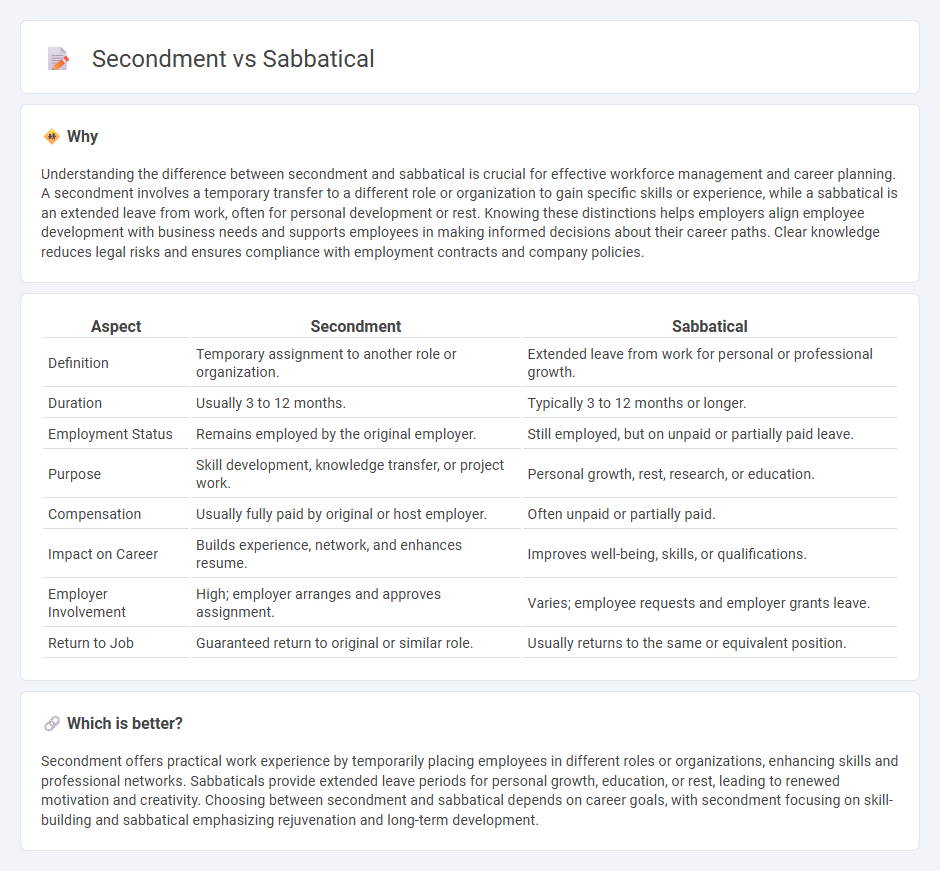
Secondment involves temporarily assigning an employee to another role or organization to gain specific skills and experience, often benefiting both the individual and the employer through knowledge transfer. Sabbaticals provide employees with extended paid or unpaid leave to pursue personal development, research, or rest, enhancing long-term job satisfaction and productivity. Explore more about how secondments and sabbaticals can strategically enhance your career and organizational growth.
Why it is important
Understanding the difference between secondment and sabbatical is crucial for effective workforce management and career planning. A secondment involves a temporary transfer to a different role or organization to gain specific skills or experience, while a sabbatical is an extended leave from work, often for personal development or rest. Knowing these distinctions helps employers align employee development with business needs and supports employees in making informed decisions about their career paths. Clear knowledge reduces legal risks and ensures compliance with employment contracts and company policies.
Comparison Table
| Aspect | Secondment | Sabbatical |
|---|---|---|
| Definition | Temporary assignment to another role or organization. | Extended leave from work for personal or professional growth. |
| Duration | Usually 3 to 12 months. | Typically 3 to 12 months or longer. |
| Employment Status | Remains employed by the original employer. | Still employed, but on unpaid or partially paid leave. |
| Purpose | Skill development, knowledge transfer, or project work. | Personal growth, rest, research, or education. |
| Compensation | Usually fully paid by original or host employer. | Often unpaid or partially paid. |
| Impact on Career | Builds experience, network, and enhances resume. | Improves well-being, skills, or qualifications. |
| Employer Involvement | High; employer arranges and approves assignment. | Varies; employee requests and employer grants leave. |
| Return to Job | Guaranteed return to original or similar role. | Usually returns to the same or equivalent position. |
Which is better?
Secondment offers practical work experience by temporarily placing employees in different roles or organizations, enhancing skills and professional networks. Sabbaticals provide extended leave periods for personal growth, education, or rest, leading to renewed motivation and creativity. Choosing between secondment and sabbatical depends on career goals, with secondment focusing on skill-building and sabbatical emphasizing rejuvenation and long-term development.
Connection
Secondment and sabbatical both involve temporary leaves from an employee's primary job, facilitating professional growth and skill development. Secondments typically assign employees to different roles or locations within or outside their organization to gain experience, while sabbaticals provide extended time off for personal or academic pursuits. Both practices enhance employee engagement, retention, and career progression within the employment framework.
Key Terms
Leave of Absence
A leave of absence can be categorized as either a sabbatical or a secondment, each serving distinct professional and personal purposes. Sabbaticals typically offer employees extended time off for rest, research, or personal development, often unpaid but with job security. Explore the differences between sabbatical and secondment leave options to optimize your career planning.
Temporary Assignment
A sabbatical is a planned, extended leave from work often used for personal growth or academic pursuits, while a secondment is a temporary assignment within the same organization or to a partner company to fulfill specific operational needs. Both options offer valuable opportunities for skill development and career advancement but differ in purpose and structure. Explore the distinct benefits and applications of sabbaticals and secondments to decide which temporary assignment suits your professional goals best.
Job Continuity
A sabbatical offers employees extended leave for personal or professional growth while maintaining their original job position, ensuring seamless job continuity upon return. A secondment involves temporarily transferring an employee to a different role or department within the organization, preserving employment continuity through skill development and networking. Explore more to understand how each option supports career progression and job security.
Source and External Links
Sabbatical - Wikipedia - A sabbatical is an extended period of rest or break from work, originally based on the Biblical shmita (sabbatical year) practice, now commonly offered by academic institutions to allow employees time to rest or pursue non-routine work activities while remaining employed.
Sabbatical | Adobe Benefits - Adobe offers a paid sabbatical leave program for U.S. employees after five years of continuous employment, allowing them extended time off to recharge, with the length increasing with tenure and the option to use the time for personal projects or volunteering.
What Is Sabbatical Leave? It's the Best Kept Secret in HR | BetterUp - A sabbatical is a paid or unpaid extended leave from work during which employees can rest or pursue other interests, originally from academia but increasingly offered in other sectors to improve retention and productivity.
 dowidth.com
dowidth.com